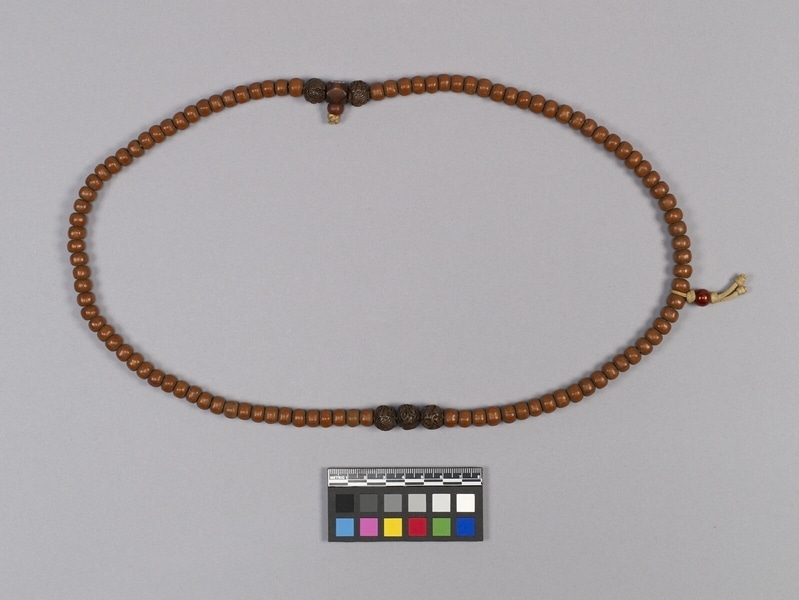Beads Item Number: Ee27 from the MOA: University of British Columbia

Description
A string of one-hundred-and-ten beads on white cotton cord, one-hundred-and-four of which are spherical orange-brown seeds with a fine mottled surface that have faint striations. String forms a circle, at one side of which, there are three deep-carved beads of brown wood. At the opposite side, there are two identical beads to which are attached a smaller red-brown seed-bead with a spherical orange-brown seed, knotted on with the ends of the cord on which the beads are strung. Tied around the string of beads is braided white cotton cord, on which an amber ? bead is knotted. Cord is 4.4cm. long.
History Of Use
These beads may be of Hindu origin. They are particularly used by the Mahayana School of Buddhism, and are widely used in Tibet, China, and Japan. In Tibet they are used by lamas in repeating the mantra of a particular deity, while lay men use them in repetition of the Mani Formula, six syllables which are believed to assure the person rebirth in the western paradise of the Buddha of boundless light. The six syllables of the Mani are rich in symbolic meaning and subject to many interpretations.
Iconographic Meaning
The number 108 is sacred in Hindu and Buddhist traditions. Certain sacred texts have 108 volumes, and deities have 108 names.
Cultural Context
prayer beads
Item History
- Made in China before 1953
- Collected between 1898 and 1953
- Owned by Marion Stephan
- Owned by Charles H. Stephan before January 10, 1977
- Received from Charles H. Stephan (Donor) on January 10, 1977
What
- Name
- Beads
- Identification Number
- Ee27
- Type of Item
- bead
- Material
- seed, wood, amber stone ? and cotton fibre
- Manufacturing Technique
- bored, spun, braided, cut and carved
- Overall
- height 36.0 cm, width 14.0 cm, depth 1.9 cm
Who
- Culture
- Tibetan
- Previous Owner
- Marion Stephan and Charles H. Stephan
- Received from
- Charles H. Stephan (Donor)
Where
- Holding Institution
- MOA: University of British Columbia
- Made in
- China
When
- Creation Date
- before 1953
- Collection Date
- between 1898 and 1953
- Ownership Date
- before January 10, 1977
- Acquisition Date
- on January 10, 1977
Other
- Condition
- good
- Accession Number
- 0352/0221